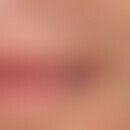Synonym(s)
Salazosulfapyridine
DefinitionThis section has been translated automatically.
Half-lifeThis section has been translated automatically.
8 h or 2,7-10 h (metabolites).
You might also be interested in
IndicationThis section has been translated automatically.
M. Crohn's disease (see regional enteritis), ulcerative colitis, rheumatoid arthritis, seronegative spondarthritis (psoriatic arthritis), majoraphthae.
Limited indicationThis section has been translated automatically.
Pregnancy, lactation, glucose-6-phosphate dehydrogenase deficiency, children < 2 years, thyroid dysfunction.
Dosage and method of useThis section has been translated automatically.
Gradual dosage of 500 mg p.o. twice a day or rectally for 14 days, then increase to 500 mg three times a day for 14 days, then 1000 mg twice a day, maximum dose 3 g/day.
Notice! Caution with glucose-6-phosphate dehydrogenase deficiency. During the first months of therapy control of BB and diff. BB, transaminases, creatinine every 14 days, later every 4 weeks to 3 months. Additionally every 6 months control of antinuclear antibodies in serum!
Undesirable effectsThis section has been translated automatically.
5-50% of patients have side effects, mostly dose-dependent at doses > 4 g/day or serum levels > 50 μg/ml.
- Cutaneous side effects: Among others, allergic reactions, photosensitization, drug-induced LE, triggering of pemphigus vulgaris.
- Extracutaneous side effects: Alveolitis, bronchospasm, BB changes, methemoglobinemia, gastrointestinal disturbances, hepatitis, cholestasis, exacerbation of ulcerative colitis, pancreatitis, parotitis, oliguria, hematuria, yellow-orange discoloration of urine, nephrotic syndrome, vasculitis, hypospermia, hypertension, palpitations, myocarditis, headache, depression, neuropathy, paresthesias, yellow-orange discoloration of contact lenses, visual, hearing and taste disturbances, induction of acute porphyria.
InteractionsThis section has been translated automatically.
See Table 1.
ContraindicationThis section has been translated automatically.
For example exfoliative dermatitis, haemoglobin anomalies, haemolytic anaemia, ileus, severe liver or kidney damage, paragroup allergy in children, acute hepatic porphyria, hypersensitivity to sulphonamides or salicylates.
PreparationsThis section has been translated automatically.
Azulfidines
PatientinformationThis section has been translated automatically.
Contact lens wearers should be informed about the possibility of yellow-orange discoloration of contact lenses!
TablesThis section has been translated automatically.
Major interactions of sulfasalazine
Anion exchange resins |
Sulfasalazine levels ↓ |
Coumarins |
Bleeding tendency ↑ |
Phenytoin |
Phenytoin effect ↑ |
Hypoglycemia |




